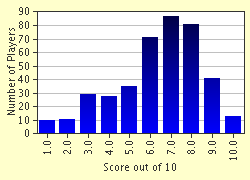Quiz Answer Key and Fun Facts
1. Dr. Blarg has devised a cunning escape system, whereby if you push the button of the right answer choice, a door will open and you will proceed into the next room, unharmed. If you push the wrong button, you will be instantly electrocuted! (Cue the evil laughter.) The mineral in question is an olive green color. However, it is only a fragment, so you can't determine the crystal system, and it is located in a glass box, so you can't touch it or taste it or scratch it or even determine the crystal system. Blarg is evil indeed. However, the answer choices should elucidate the identity of the mineral. Will you proceed, or be electrocuted?
2. Our next mineral involves a taste test. The mineral itself is transparent and cube-shaped. It tastes salty. Now which mineral would this be? Let's not mention that if you guess incorrectly, you will be dropped into the pond of unfed crocodiles below. The salt will just serve to season their meal. That would be unfortunate, would it not? To lose such an interesting mineral specimen?
3. Now, if you don't get this one correct, we'll just release the undead warriors, and... Oh, hello there. Ahem. This mineral is the major constituent of limestone and marble. It also has quite a few interesting properties. It effervesces vigorously in dilute hydrochloric acid. That's much better than saying it fizzes, right? Right. It has perfect cleavage and breaks into rhombohedrons. One form known as Iceland Spar is transparent, and splits light into two different rays-- so if you put it on top of a dot, you'll see two dots. Dotty! Heh heh... And, for you added pleasure, this question is fill in the blank. I am SO evil!
4. For your inspection, you are given the wedding ring of Mrs. Blarg. If you identify the stone incorrectly, Mrs. Blarg herself will deal you doom. The stone is transparent and has high fire, but there is some chipping of the crystal edges, and the stone seems to have a hardness of about 7 on the Mohs scale. What mineral is it?
5. Our next mineral is magnetic, a sort of opaque black or brown color, and dense. If you don't guess this one correctly, and you ought to, since the name is somewhat obvious (Oooohh! I said too much!), we'll just direct the large meteorite at your location, and...
6. For this next mineral, if you don't get it right, you shall eat this lovely little plate of chocolates, which, unfortunately, are laced with toxic chemicals. Oh dear. I seem to have lost my ap... Hey! No puns! No puns! Aha. This mineral forms hexagonal prisms, has a hardness of 5, and consists of calcium phosphate. It is also the major constituent of bones and teeth. Now, what is this mineral, exactly?
7. Zee next mineral eez sovt and gvray and shinee and zee... I don't know what accent I'm trying to fake, but obviously I'm not doing it very well. Vell, eef you haf seen zees mineral, you have probably seen it in PENCEELS! Vich make good arrows. Another form of zee carbon, other zan diamond.
8. Now on to the wonderful world of chains silicates. Their molecular structure consists of chains of silica tetrahedrons linked in either a single or a double chain. Chains? Chains? Oh. That's what you'll be getting. That and a rather deep river. Anyway, the two most common chain silicates are pyroxene and amphibole. They are so similar, is it even possible to reliably tell them apart in hand sample? I'm not even asking you to identify them. Ugh. I seem to be becoming weak-minded.
9. The identification criteria are becoming more and more complex and convoluted, just like the mind of Dr. Blarg. This time, you are gazing at a thin section in a petrographic microscope. The question this time? Is the mineral under the crosshairs quartz, or feldspar? If it's feldspar, what kind? You determine that the mineral goes extinct as you rotate the microscope stage under crossed polars, exhibits albite twinning, and is biaxial positive. What is it? Keep in mind that, if you answer incorrectly, your chair, actually an ejector seat from a fighter plane, will hurl you into the gorge below, where you will meet certain death.
10. Finally, Dr. Blarg allows us to identify a powdered mineral specimen using X-ray crystallography. If we don't guess correctly, of course, we'll get put in the X-ray source, "we" being, of course, not you and I, just you. X-ray crystallography measures the d-spacings of different minerals, that is, how far apart the atoms are spaced in the crystal lattice, and the intensity of light that is reflected. For your mineral, you measure d-spacings of 3.22, 1.70, and 2.51, and relative intensities of 100, 52, and 39. You hastily look up a number of minerals in that exciting, best-selling database from the International Center for Diffraction Data (at the extra low price of $6,100, software to search the database extra.) You find the following data for the following minerals. Which one is it?
Source: Author
pu2-ke-qi-ri
This quiz was reviewed by FunTrivia editor
crisw before going online.
Any errors found in FunTrivia content are routinely corrected through our feedback system.

